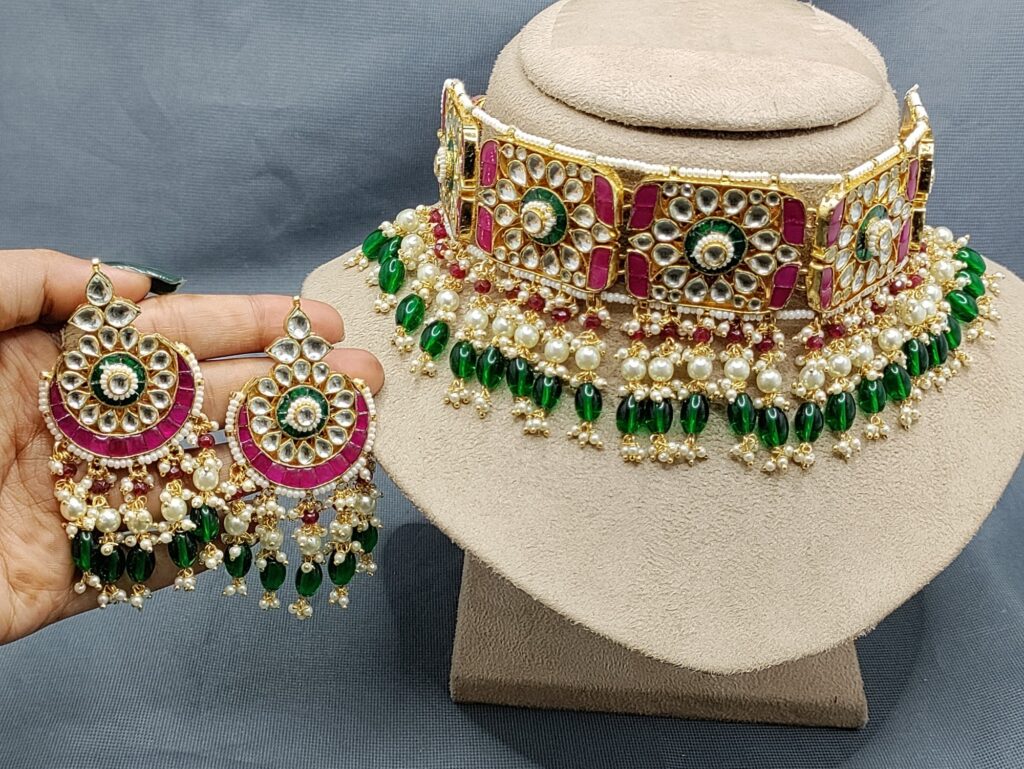In the realm of Indian craftsmanship and heritage, few art forms stand as majestic and enduring as Kundan jewelry. Originating in the royal courts of Rajasthan and Gujarat centuries ago, Kundan jewelry has transcended time, evolving into a symbol of tradition, elegance, and opulence. This article delves into the rich history, exquisite craftsmanship, contemporary relevance, and cultural significance of Kundan jewelry, exploring its allure that continues to captivate connoisseurs worldwide.
The Origins of Kundan Jewelry
The origins of Kundan jewelry can be traced back to the Mughal era in the 16th century. It was during this period that skilled artisans perfected the art of setting gemstones in gold, giving birth to what we now know as Kundan jewelry. The word “Kundan” itself is derived from the Sanskrit word “Kundanam,” meaning refined gold.
Craftsmanship: A Labor of Love
Creating Kundan jewelry is a meticulous and labor-intensive process that requires exceptional skill and precision. The craftsmanship involves setting precious gemstones, typically uncut diamonds (polki) and colored glass, into elaborate designs crafted from pure gold. The gems are secured using a technique known as “kundan setting,” where the stones are encased in a framework of pure molten gold. This process not only enhances the beauty of the gemstones but also ensures their durability.
The Significance of Kundan Jewelry in Indian Culture
Kundan jewelry holds a special place in Indian culture, symbolizing wealth, prosperity, and timeless beauty. It is an integral part of traditional Indian weddings and celebrations, adorning brides with its exquisite craftsmanship and ornate designs. Beyond its aesthetic appeal, Kundan jewelry is also believed to have spiritual significance, with certain gemstones thought to possess healing properties and bring good fortune to the wearer.
Evolution and Adaptation
While Kundan jewelry remains deeply rooted in tradition, it has also evolved to embrace contemporary tastes and trends. Modern designers have reimagined classic Kundan designs, infusing them with a touch of innovation and experimentation. This fusion of tradition and modernity has broadened the appeal of Kundan jewelry, attracting a new generation of admirers both in India and abroad.
The Global Appeal of Kundan Jewelry
In recent years, Kundan jewelry has gained popularity on the global stage, captivating fashion enthusiasts and celebrities alike. Its intricate designs and luxurious appeal have made it a favorite choice for red carpet events and high-profile occasions. International fashion houses and designers have also taken note of Kundan jewelry, incorporating elements of its craftsmanship into their own collections.
Preserving a Heritage
Despite its enduring popularity, the art of Kundan jewelry making faces challenges in the modern era. Economic factors, changing consumer preferences, and the availability of cheaper alternatives pose threats to traditional artisans and their craft. Efforts are underway to preserve this cultural heritage, with organizations and artisans working together to promote awareness and appreciation for Kundan jewelry.
Challenges and Opportunities
Despite its cultural significance, Kundan jewelry faces several challenges in the modern era. One such challenge is the availability of cheaper, mass-produced imitations flooding the market. These imitations, often made with inferior materials and lacking the intricate craftsmanship of authentic Kundan jewelry, threaten to dilute its legacy. Additionally, economic factors and changing consumer preferences pose hurdles for traditional artisans, many of whom struggle to compete in a rapidly evolving market.
However, amidst these challenges lie opportunities for innovation and revitalization. Collaborations between traditional artisans and contemporary designers offer a promising avenue for preserving Kundan jewelry while infusing it with fresh perspectives. By embracing sustainable practices, promoting ethical sourcing of materials, and leveraging digital platforms for marketing and sales, artisans can adapt to the demands of the modern marketplace without compromising on quality or authenticity.

Education and Awareness
Education and awareness play crucial roles in ensuring the continued appreciation and patronage of Kundan jewelry. Initiatives aimed at educating consumers about the craftsmanship behind Kundan jewelry, its cultural significance, and the importance of supporting traditional artisans can help foster a deeper connection with this timeless art form. Museums, exhibitions, and cultural festivals provide platforms for showcasing the beauty and craftsmanship of Kundan jewelry, sparking interest and admiration among audiences both domestically and internationally.
Furthermore, empowering artisan communities through skill development programs, access to resources, and fair trade practices is essential for sustaining the heritage of Kundan jewelry. By investing in the livelihoods of artisans and providing avenues for their work to reach global markets, we can ensure that the tradition of Kundan jewelry making thrives for generations to come.
A Legacy Preserved
In the face of modernization and globalization, preserving the heritage of Kundan jewelry is not merely an act of nostalgia but a testament to the resilience of cultural traditions. It is a celebration of craftsmanship, creativity, and the enduring spirit of community that sustains artisanal practices around the world. As we cherish the beauty of Kundan jewelry, let us also honor the legacy of those who have dedicated their lives to preserving this exquisite art form, ensuring that it continues to shine brightly for centuries to come.
Conclusion
In conclusion, Kundan jewelry stands as a testament to the timeless beauty and craftsmanship of Indian artisans. Its rich history, intricate designs, and cultural significance make it a cherished treasure not just in India but across the globe. As we continue to celebrate and embrace the legacy of Kundan jewelry, let us also strive to ensure its preservation for generations to come, keeping alive the spirit of tradition and craftsmanship that defines this iconic art form.
